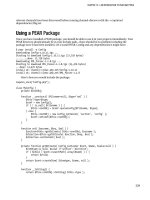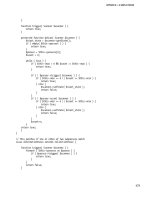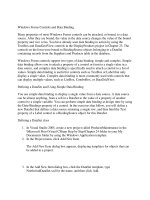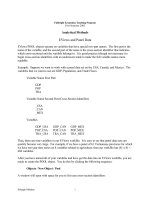Tài liệu Integra™ Subtalar MBA® and bioBLOCK® Implant ppt
Bạn đang xem bản rút gọn của tài liệu. Xem và tải ngay bản đầy đủ của tài liệu tại đây (1.48 MB, 12 trang )
SURGICAL TECHNIQUE
Integra
™
Subtalar MBA® and bioBLOCK® ImplantTable of contents
Introduction
Description 2
Indications 2
Contraindications 2
Surgical Technique
Step 1: Incision and Dissection 3
Step 2: Probe Insertion 4
Step 3: Guide Pin Insertion 4
Step 4: Sizer Insertion 5
Step 5: Trial Implant Insertion 6
Step 6: Intra-Operative Radiographs 6
Step 7: Implantation 7
Step 8: bioBLOCK® Implant Intra-Operative Imaging 7
Step 9: Guide Pin Removal and Closure 8
Step 10: Post-Op / Follow-Up 8
Subtalar MBA® Implant and bioBLOCK® Implant - Instrument Tray Back Cover
Ordering Information Back Cover
1
Subtalar MBA® Implant Description
The Subtalar MBA® titanium implant is the original,
time-tested metallic arthroereisis implant for the
correction of hyperpronated fat.
Indications
The Subtalar MBA® Implant indicated for use in the
treatment of the hyperpronated foot and stabilization of
the subtalar joint. It is designed to block the anterior and
inferior displacement of the talus, thus allowing normal
subtalar joint motion but blocking excessive pronation
and resulting sequela.
• Severly pronated foot
• Walking intemperance
• Calcaneal stance position greater than 5°
• Manually correctable deformity
• Mid-tarsal breech (arch pain)
• Forefoot varus greater than 10°
Contraindications
• Vertical calcaneus
• Rigid atfoot (unreducible)
• Rearfoot varus
• Peroneal spasm
• Ankle joint valgus
• Excessive ligament laxity
• Degenerative joint disease of the subtalar joint
• Severe obesity
• Asymptomatic atfoot condition
• Patients less than 3 years of age
bioBLOCK® Implant Description
The bioBLOCK® Implant is a resorbable arthroereisis device
constructed of poly-L-lactic acid (PLLA). It is designed to
provide support and hold the foot in alignment while
adjunctive procedures heal.
Indications
The bioBLOCK® Implant is indicated for internal support to
primary surgical interventions in the treatment of atfoot.
Contraindications
• Vertical calcaneus
• Rigid atfoot (unreducible)
• Rearfoot varus
• Peroneal spasm
• Ankle joint valgus
• Excessive ligamentous laxity
• Degenerative joint disease of the subtalar joint
• Severe obesity
• Asymptomatic atfoot condition
• Patients less than 3 years of age
Pre-Operative Considerations
In order to ensure the bioBLOCK® Implant provides adequate
support and correction, Integra LifeSciences Corporation
recommends that the bioBLOCK® Implant not be used in
patients weighing more than 250 pounds. Exceeding this
weight may cause the shape of the implant to change,
resulting in deformation of the implant shape. The implant
may still provide support and correction in this altered state,
however it is not recommended.
2
1- 2
Surgical Technique
Step 1 • Incision and Dissection
As the manufacturer of this device, Integra LifeSciences Corporation does not practice medicine and
does not recommend this or any other surgical technique for use on a specific patient. The surgeon who
performs any procedure is responsible for determining and using the appropriate technique in each patient.
Caution: Federal law restricts this device to sale by or on the order of a physician or practitioner.
The surgical technique is performed through a 2-4cm skin
incision over the sinus tarsi along the relaxed skin tension lines
(Figure 1-1).
Care should be taken to avoid the intermediate dorsal cutaneus
nerves superior to the incision as well as the sural nerve which
should course inferior to the incision.
The deep fascia is identified and bluntly dissected allowing
entrance into the sinus tarsi canal. It is important that minimal
blunt dissection only be performed in the sinus tarsi. A (sinus
tarsi) exposure or sectioning of the talo-calcaneal ligament
structures is not performed (Figure 1-2).
1 - 1
1- 1
3
Step 2 • Probe Insertion
Step 3 • Guide Pin Insertion
The guide pin is then inserted into the sinus tarsi from
lateral to medial until tenting is noted on the medial aspect
of the foot (Figure 3-1). The guide pin should be positioned
on the oor of the calcaneus and against the lateral process
of the talus as the pin is inserted from lateral to medial and
slightly posterior. It is suggested that a small incision be
made minimally to allow passage of the guide pin through
the medial aspect of the foot, just inferior to the tibialis
posterior tendon and anterior and slightly inferior to the
medial malleolus.
Note: Tenting is optional.
3- 1
3- 1
45°
15°
0°
Guide Pin
Insert the yellow probe instrument through the sinus tarsi into
the sinus canalis from lateral to medial until tenting is noted
on the medial aspect of the foot (Figure 2-1).
The probe should be positioned perpendicular to the lateral
wall of the calcaneus, angeled slightly posterior and superior.
Move the probe in a clockwise and counter clockwise
direction to slightly dilate the tarsal canal.
Remove probe.
2- 1
2- 1
Probe “YELLOW”
4
Step 4 • Sizer Insertion
Subtalar MBA® Implant Sizer Insertion
Place the cannulated 6mm sizer over the guide pin and insert
it through the sinus tarsi into the sinus canalis from lateral to
medial (Figure 4-1).
Continue to insert the remaining sizers (8, 9, 10, 12mm)
through the sinus tarsi lateral to medial until proper
correction is achieved.
Assess the range of motion of the subtalar joint.
The appropriate sizer should limit “abnormal” joint eversion.
The appropriate size will allow the calcaneal subtalar joint
complex to evert to approximately 2-4 degrees. However,
a rectus calcaneal position is acceptable, and usually preferred.
bioBLOCK® Implant Sizer Insertion
Place the cannulated 8mm sizer over the guide pin and insert
it through the sinus tarsi into the sinus canalis from lateral to
medial (Figure 4-2).
Continue to insert the remaining sizers (9, 10, 11, 12mm)
through the sinus tarsi lateral to medial until proper
correction is achieved.
Assess the range of motion of the subtalar joint.
The appropriate sizer should limit “abnormal” joint eversion.
The appropriate size will allow the calcaneal subtalar joint
complex to evert to approximately 2-4 degrees. However,
a rectus calcaneal position is acceptable, and usually preferred.
Note: An 11mm bioBLOCK® Implant is available; however,
there is not a corresponding 11mm Sizer. If the 12mm
over-corrects the deformity, and the 10mm Sizer provides
too lile correction, the 11mm implant is recommended.
4 - 1
4- 1
6mm Sizer “RED”
4- 2
8mm Sizer “BROWN”
5
Step 5 • Trial Implant Insertion
Step 6 • Intra-Operative Radiographs
To determine the correct position on the AP view, the leading
edge of the trial implant should approach, but not cross the
longitudinal dissection of the talus (Figure 6-1).
The trailing edge of the implant should be at least 5mm medial
to the lateral wall of the calcaneus (Figure 6-2).
Examining the lateral view, the trial implant should be angled
posterior and the implant should not be siing on the oor of
the calcaneus.
6- 1
Aer the appropriate size implant is determined, the sizer is
removed and a “sized” trial implant is placed in the sinus tarsi,
utilizing the inserting device and guide pin.
Insert the corresponding trial implant using the cannulated
3.5mm Hex combo driver (Figure 5-1).
bioBLOCK® Implant Combo Driver
• The insertion tool used to place the implant is double-sided,
with a 3.5mm hex on one end of the driver and a torx on the
opposite end of the driver.
• The metal portion of the driver may be removed from the
blue handle to switch between the two different interfaces.
• To switch from the hex to the torx interface, pull the metal
portion away from the blue handle. To expose the torx
interface, ip the metal portion over, and insert the 3.5mm
hex interface into the blue handle. Range of motion of
the subtalar joint and clinical correction is assessed and
determined.
Use Intra-operative imaging to evaluate the degree of
correction and placement of the Trial implant.
5- 1
5- 1
Combo Driver “BLUE”
6- 1
Guide Pin
6
6- 2
5mm
Step 7 • Implantation
Once the appropriate sized trial implant is determined, remove the trial implant.
The equivalent size sterile implant is placed onto the insertion tool (bioBLOCK® Implant is placed into the torx side
of the combo driver) over the guide pin and threaded in a clockwise direction until clinical correction is noted.
Intra-operative imaging is essential to verify proper positioning of the implant.
Subtalar MBA® Implant refer to Step 6.
bioBLOCK® Implant refer to Step 8.
Once the implant has been properly positioned, assess the range of motion of the subtalar joint.
The appropriate size will allow 2-4 degrees of subtalar joint eversion.
7 - 1
Step 8 • bioBLOCK® Implant Intra-Operative Imaging
The bioBLOCK® Implant is not visible under uoroscopy, but the
leading and trailing edges of the implant may be viewed using
the combo driver (Figure 8-1).
The combo driver is le in place during imaging. The leading
edge of the tool indicates the leading edge of the Implant.
It is recommended that the guide wire be retracted laterally into
the placement driver, so that only the tip of the driver is visible
under the uoroscopy.
The trailing edge of the driver’s torx feature indicates the trailing
edge of the implant.
8 - 1
8- 1
Simulated uoroscopy
7
Step 9 • Guide Pin Removal and Closure
Remove the guide pin medially if the small incision was made
during Step 3 of the procedure (Figure 9-1).
Note: If tenting was performed, the guide pin will be
removed laterally.
Copiously irrigate the area with saline and reevaluate subtalar
joint motion.
Close the deep tissue fascia, subcutaneous and skin layers.
Place the foot in a mildly compressive dressing.
9 - 1
9- 1
Step 10 • Post-Op / Follow-Up
Restrict ambulation for the first 48 hour, followed by protective weight-bearing in a removable, below-the-knee
walking cast for two weeks.
Allow a gradual return to activity over the course of the next month.
Note: Typically, adjunctive procedures are performed, so the appropriate post-operative care should be followed
for these procedures.
10 - 1
8
9
Subtalar MBA and bioBLOCK are registered trademarks of Integra LifeSciences Corporation.
Integra and the Integra logo are trademarks of Integra LifeSciences Corporation.
©2011 Integra LifeSciences Corporation. All rights reserved. Printed in the USA 1.5K ER4803-6/11
Subtalar MBA® Implant Features
• The Subtalar MBA® Implant system has the longest
history of successful clinical outcomes.*
• Barrel-shaped implant provides optimal medial support.
• Uniform implant diameter minimizes lateral discomfort.
• Patented sloed design helps prevent extrusion.
• Simple, minimally-invasive surgical procedure.
*Data available upon request.
Component Materials
• Subtalar Implant: Titanium Alloy
bioBLOCK® Implant Features
• Constructed of poly-L lactic acid (PLLA).
• Provides temporary support while adjunctive
procedures heal.
• Ideal for patients with metal sensitivity.
• Provides an alternative treatment option to a
metallic device.
• Simple, minimally-invasive surgical procedure.
• Driver allows viewing under uoroscopy.
Component Materials
• Subtalar Implant: poly-L lactic acid (PLLA)
Reference
05-0106 Subtalar Implant 6mm
05-0108 Subtalar Implant 8mm
05-0109 Subtalar Implant 9mm
05-0110 Subtalar Implant 10mm
05-0112 Subtalar Implant 12mm
05-0017 Guide Pin 2mm (.078 in.)
04-1040 Combo Driver
05-5000 Instrument Set
Description Size
Reference
04-0008 Subtalar Implant 8mm
04-0009 Subtalar Implant 9mm
04-0010 Subtalar Implant 10mm
04-0011 Subtalar Implant 11mm
04-0012 Subtalar Implant 12mm
05-0017 Guide Pin 2mm (.078 in.)
04-1040 Combo Driver
05-5000 Instrument Set
Description Size
bioBLOCK® Implant Combo Driver
• The insertion tool used to place the implant is double-sided, with a 3.5mm hex on
one end of the driver and a torx on the opposite end of the driver.
• The metal portion of the driver may be removed from the blue handle to switch
between the two different interfaces.
• To switch from the hex to the torx interface, pull the metal portion away from the
blue handle. To expose the torx interface, ip the metal portion over, and insert the
3.5mm hex interface into the blue handle. Range of motion of the subtalar joint and
clinical correction is assessed and determined.
Integra
Subtalar MBA® and BioBLOCK® Implant
For more information or to place an order, please contact:
Integra
n
311 Enterprise Drive, Plainsboro, NJ 08536
877-444-1122 USA
n
609-936-5400 outside USA
n
866-800-7742 fax
integralife.com









